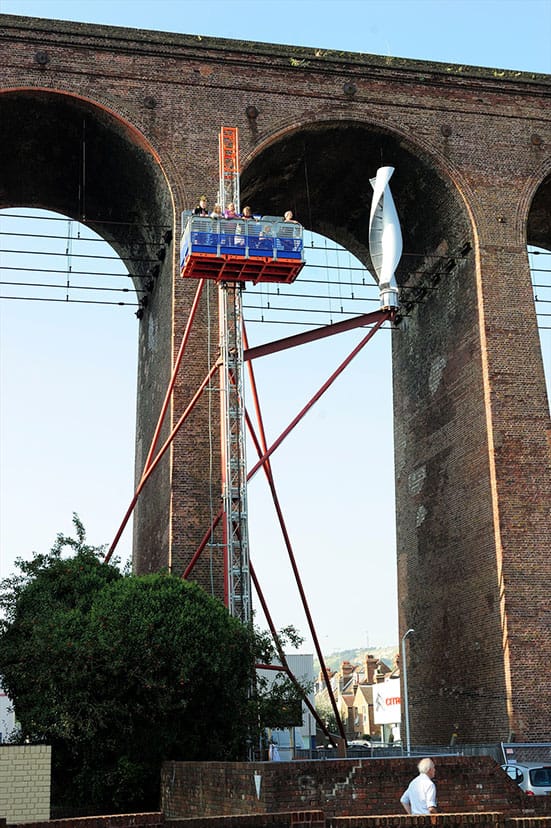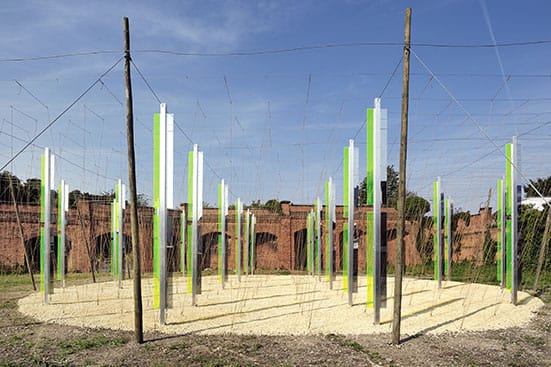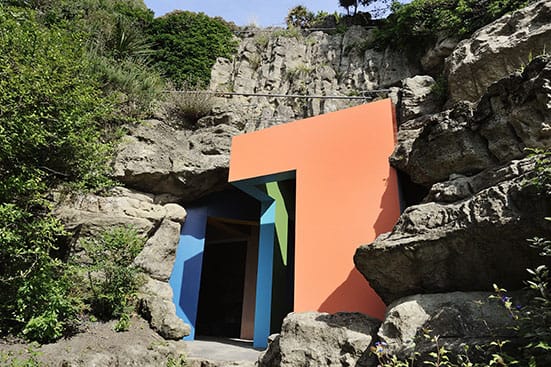A man is lying in the street, supine in the rain. As people walk by they look mildly suspicious or concerned, or they point and smirk, or they ignore him altogether. The man pays them all no heed and goes on lying there in a zen-like calm as the rain falls softly. After a while he gets up and walks off, leaving behind an imprint of his body formed by the dry patch he has made on the ground. At first, a few passers-by instinctively avoid stepping upon this trace, this absence, but soon it goes unnoticed and the space is tramped over once more, and before long this fleeting pavement memory has been obliterated.
Obliterated but also recorded, because the man lying in the street is artist Andy Goldsworthy and the scene has been captured on video as one of several quietly compelling works he has created in Folkestone for its third Triennial. Goldsworthy has been making these ‘rain shadows’ for thirty years in various locations around the world, and a conceit that could easily have slipped into whimsy is actually carried off with a lightness of touch – aptly so for a piece concerned with the impermanence of the impressions we make in the world.
Ephemerality – even when it is undercut by being committed to video – is of course one of Goldsworthy’s signatures, and the more ephemeral the better; I’ve seldom been a great admirer of his more permanent interventions in the landscape. Indeed, I hadn’t expected to find his contributions to the Triennial to be amongst the strongest in this year’s show, but he really seems to be in his element in Folkestone. For his other video piece Goldsworthy covers a rock in blood-red poppy petals and we watch as a gentle tide slowly washes them away out to sea. An almost too-obvious meditation on the troops that departed the town a century ago for the killing fields of Flanders, it ends up being highly affecting, its pulsing time-lapse rhythm and seashore soundtrack lulling us into a reverie for the long-departed.
His main two pieces here, created in an empty shop on the Old High Street (outside which the Rain Shadow video was recorded) find him encrusting a window and a staircase with clay taken from the local beach. As the drying clay contracts and cracks, what had at first blocked out the light from the window becomes fissured into an intricate mosaic of fractured illumination. Light and dark, wet and dry, presence and absence, hereness and thereness, looking out and looking in: these are the binary ingredients of a tight body of work here that exhibits a playfulness and an integrity, a spontaneity as well as a poetic wit. Musing on the perennial Folkestone topic of immigration, a small photo depicts the artist seemingly dashed against a mesh fence near the harbour’s lorry park, like something that’s been discarded and blown about in the wind, before coming to rest in a state of suspension.
A more conceptual concern with the elements is apparent in one of the other ‘big name’ artists here: the late Ian Hamilton Finlay, whose estate have arranged for one of the artist’s ‘detached sentences’ to be painted onto the small lighthouse at the tip of the harbour arm. ‘Weather is a third to place and time’, it reads, although we can only view it by peering through binoculars further up the pier, because much of the quayside is closed off due to building works. Whilst this creates a problem in terms of claiming Hamilton Finlay as its sole author, having to view it in this way becomes integral to the experience of the piece, chiming nicely with the nominal theme of the Triennial, which this time is called Lookout. It makes for an interestingly detached and rather alienating encounter – like the lighthouse in Virginia Woolf’s novel, attaining it proves frustratingly elusive – and this becomes the work’s overarching concern. Desire, projection, investment: the disconnected viewer chooses whether and how to imbue the aridity of conceptual language with the endless richness of memory and imagination. Another language-based work further up the pier at the disused Folkestone Harbour station is much less effective. A faux-profundity spelled out in neon, it rather serves to demonstrate how difficult it is to meet the challenge of making artwork for such an already evocative location as this crumbling terminus.
The Lookout theme is again encapsulated nearby in Alex Hartley’s Vigil, for which, near the top of the Grand Burstin – the harbour-front hotel designed in the shape of an ocean liner – he has erected a sort of vertical campsite using mountaineering gear, where he and his assistants will apparently sometimes perch throughout the course of the Triennial. Given that it wasn’t possible to actually go up and see this elaborate set-up at close quarters (‘there is no public access to this artwork’), the whole thing rather smacked of an artist’s exclusivity, as though it was an ironic joke on Hartley’s part about the higher vision of the great creator, inaccessible to the mere mortals below. The blurb claims that the piece echoes the Occupy movement, but the central concern of that movement lay in its democracy. As Hartley and his chums look out from this enjoyably absurd crow’s nest, the rest of us can do no more than look up (briefly and indifferently), and my main instinct was to go and look at something else.
But when one door closes, another door opens, and the desire to experience one’s own vertiginous lookout is amply supplied in a far more interesting manner by taking a trip in The Wind Lift. This ingenious contraption – created by the design practice Ooze and the artist Marjetica Potrc, and powered entirely by wind turbines that store up energy when the lift is not in use – has been set up at the base of Folkestone’s mighty railway viaduct and transports you to a height of 25 metres from which to survey the town, and indeed the majestic arches of this splendid brick viaduct, from a unique perspective.
Just behind the viaduct is the site of Folkestone’s old gasworks, where Jyll Bradley has created a complex and fascinating sculpture on the exact site of a long-demolished gasometer (another trace of an absence). Called Green/Light, and not lending itself to easy description, it comprises twenty or so aluminium poles attached to fluorescent tube lights arranged in a symmetrical pattern inside the gasometer’s footprint. These are surrounded by a kind of superstructure that replicates the layout of a hops farm - its long wooden poles and twine salvaged from one that’s been discontinued. The lights change their appearance depending on the environmental conditions, and of course the piece takes on a very different appearance when it is illuminated at night. This is a striking work that, without offering up any kind of straightforward interpretation, meditates on change and disappearance (and reappearance) in the built environment – indeed in one’s local built environment that becomes so much a part of one’s life – and the relationship between utility and beauty that exists in the often overlooked requisites of infrastructure and agriculture.
If Bradley’s piece is a kind of architecture of disappearance, Krijn de Koning’s work constitutes an architecture of replication and inversion. Dwelling comprises two identical constructions, one installed within the artificial cliffs that form Folkestone’s ‘zig zag path’, the other to be found outside the Turner Contemporary up the coast in Margate. The structure itself consists of an angular maze-like arrangement of brightly-coloured panels that together form the walls, doorways and lintels of something that inhabits – or perhaps exhabits – the interface between architecture and sculpture. An already compelling exploration of colour, space and geometric abstraction becomes a tremendously exciting piece of work through the simple yet brilliantly effective conceit of doubling its location. Experiencing the piece in both places is necessary in order to become more fully aware of the way de Koning is concerned with spatial inversion and invention; that by sculpting the space around his work the surroundings become invested in the structure, and conceived anew through our experience of being inside it. The most obvious response to the experience of Dwelling is a feeling of dislocation when the space that the structure maps out seems entirely different in the two locations, even though the dimensions of the piece itself are apparently identical. But there are all kinds of doublings and inversions operating here, and what the jolt of displacement gave rise to for me was a vivid sense of the way in which we’re forever condemned to take ourselves with us wherever we go, and yet that within these wherevers that we go, some trace of us, however transient and imperceptible, is always left behind.
David Foster

Andy Goldsworthy Clay Steps

Ian Hamilton Finlay Weather Is a Third to Place and Time

Marjetica Potrc and OOZE (Eva Pfannes & Sylvain Hartenberg) The Wind Lift

Jyll Bradley Green/Light (for M.R.)

Krijn de Koning Dwelling (for Margate/ for Folkestone)